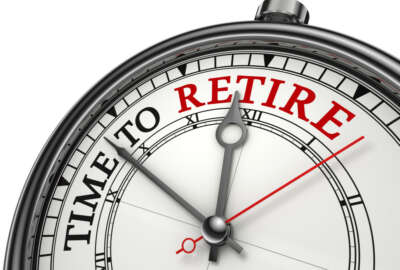
Exclusive
OPM names new CIO just as it begins initiative to modernize electronic personnel file
David Garcia comes to OPM after spending two years as the state of Maryland CIO and is a political appointee.
Subscribe to Federal Drive’s daily audio interviews on iTunes or PodcastOne
The Office of Personnel Management has a new chief information officer. Multiple sources confirmed that David Garcia, the former CIO for the state of Maryland, is starting at the agency today in the same technology executive role.
Garcia replaces Dave DeVries, who retired in September and is now the CIO for the state of Michigan. OPM made short work of finding a new CIO, bringing Garcia in as a political appointee.
Garcia, who left as the Maryland CIO in January after almost two years on the job, spent eight years in the federal market, including three as the chief of the telecommunications and network management divisions for the Army Center for Health Promotion and Preventive Medicine. He also worked for the Army as a signals intelligence analyst and as a consultant for Keane Federal Systems.

OPM’s decision to appoint Garcia comes as it’s collecting information from vendors on a new initiative to modernize the electronic personnel file.
The Sept. 15 request for information is one of the first attempts by an agency to test the theory behind the Modernizing Government Technology (MGT) Act.
OPM wants to use the savings from turning off the legacy systems to pay for future modernization efforts.
“In order to improve and enhance the federal government human capital experience and to make human capital data more effective and efficient for data-driven decision-making, OPM seeks to establish a complete, accurate and secure Employee Digital Record (EDR) that will contain all relevant employee data for the entire human capital lifecycle,” the RFI stated. “The existing environment ultimately limits the government’s ability to effectively understand the federal workforce landscape, inform strategic policy and decisions and to provide to agencies the tools and services that foster timely, data-driven decisions. Moreover, it is currently impossible to construct and exchange a single, machine-readable employee digital record throughout the federal employee’s career.”
The current environment is a hodgepodge of systems that pull data from 19 different systems and includes structured and non-structured data. To construct the current electronic personnel file, OPM must address data inaccuracies, a lack of standards across the information and business processes, and an “immense amount” of manual interaction and intervention.
OPM is asking vendors to consider all options to modernize the electronic file, including the use of share-in-savings, open source and plug-and-play technology.
OPM is holding an industry day in Washington, D.C. on Oct. 5, and responses to the RFI are due Oct. 12.
Chris Cairns, a founder of the 18F organization at the General Services Administration and now a partner with Skylight Digital, said he applauds OPM’s initiative because it’s addressing a problematic system with modern thinking.
“The big thing is to try to avoid a big-bang approach, in which nothing new is delivered and savings aren’t realized until the date the new system is turned on and the old systems are turned off,” Cairns said. “It’s important to architect a modernization path for these legacy systems that start to deliver modernized functionality/infrastructure incrementally and start to generate incremental savings.”
The fact that OPM is considering a share-in-savings approach is a huge step forward to get to the vision of the MGT Act, which sets up working capital funds in each agency where agencies can repurpose funds from turning off legacy systems.
“This is the time to talk about share-in-savings,” said Frank McNally, the director of learning and content development for the Public Spend Forum, an organization working to share best practices around public-sector procurement. “It’s wise for them to hear from industry about how share-in-savings would work, since there are a lot of open questions, including under what authority to do it, how to handle up-front termination liabilities and other related things. What OPM is saying is they need to lower their initial investment and they want to see if vendors are willing to take that ride.”
The share-in-savings concept is interesting for several reasons. First off, with OPM’s IT budget request of $37 million for infrastructure improvements likely to get cut in half in fiscal 2018, funding a huge project that involves millions of federal employees would be difficult.
Second, the vendor would have a captive audience, meaning the fluctuation in size will be minimal, as is the revenue stream that agencies pay for the service.
Cairns said share-in-savings is allowed under the Federal Acquisition Regulations and OPM, which already has a revolving fund, could take advantage of this approach.
“I think for the share-in-savings model to be a viable option here, several things need to happen. First, this is a completely new contracting approach that requires a multi-disciplinary approach. OPM should start small with a few pilot projects, working on small modernization components and learn from those,” he said. “Vendors probably won’t be willing to front 100 percent of the investment, so these initial projects will probably need to be a hybrid. For example, 75 percent of the effort funded by OPM, and the other 25 percent funded by the vendor, with hard caps on how much reward the vendor can reap. As OPM and the vendor community get better and better at these, they scale up the use of share-in-savings to cover a broader scope of modernization and shift more and more of the investment burden on vendors. You also can’t punish smaller companies who don’t have the financial capacity to invest, which is why the hybrid model could make sense.”
If OPM knows the baseline costs for the electronic personnel file today, then figuring out how much savings could come from a modernized system would open the door to this approach even more, McNally said.
Garcia should know this isn’t the first time OPM tried to modernize the electronic personnel file. The eOPF was part of the Enterprise HR Integration project under the George W. Bush administration’s e-government initiatives starting in 2003. Then in 2009, the HR Line of Business put out a report recommending the integration of these disparate systems and data. But over the last decade, progress has been limited, and the current mishmash of systems are growing older and more expensive to maintain and secure.
Additionally, Garcia should know that OPM has failed numerous times to modernize its retirement systems, which face similar challenges as the electronic personnel file, and will undoubtedly be another major priority.
Cairns said a major initiative such as this one requires a technology vision, strong leadership from the top, and maybe most importantly, the culture change management to bring the rest of the government into the modern world.
“From a delivery standpoint, I don’t think OPM can succeed without a highly technical staff in place who are government employees. I mean all-star designers, software engineers, data engineers, security engineers, etc. who are well-versed in the application of modern practices and technologies, and can help oversee and facilitate the integration of technical work products from multiple vendors,” he said.
OPM has a host of systems that are in desperate need of updating, so let’s hope a new CIO and the RFI are the first steps in this long, overdue journey.
Return to the Reporter’s Notebook
Copyright © 2025 Federal News Network. All rights reserved. This website is not intended for users located within the European Economic Area.
Jason Miller is executive editor of Federal News Network and directs news coverage on the people, policy and programs of the federal government.
Follow @jmillerWFED
Related Stories





